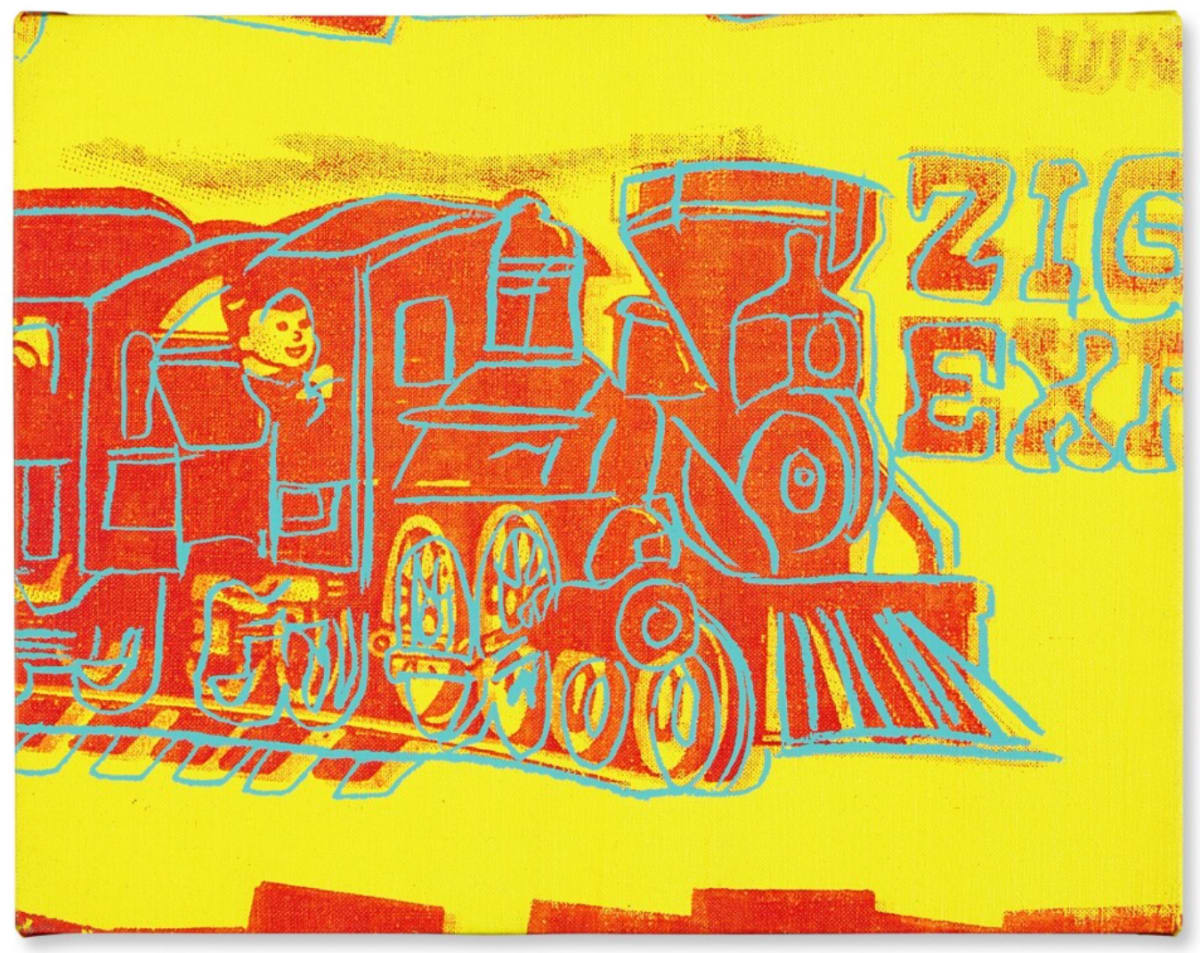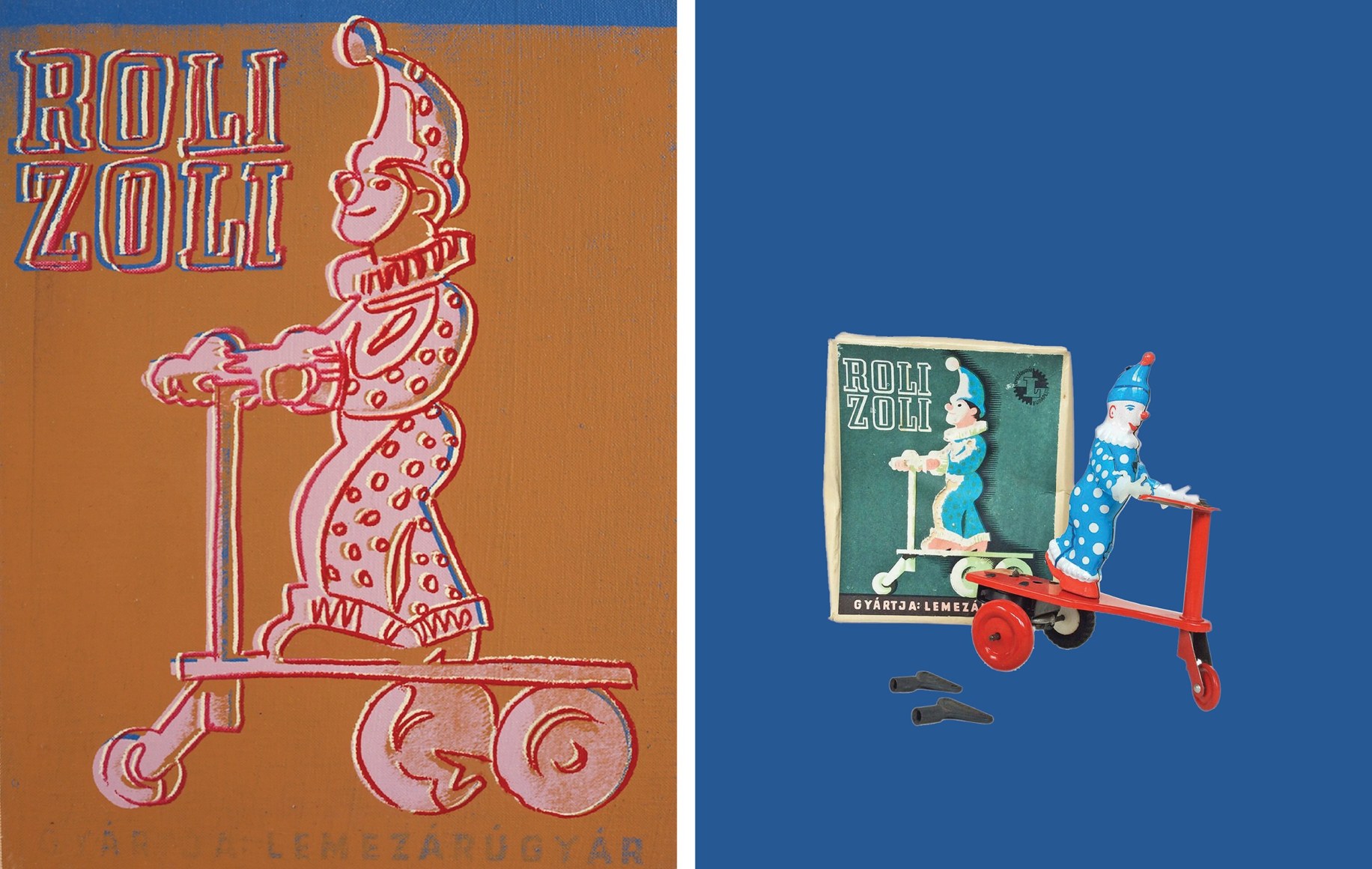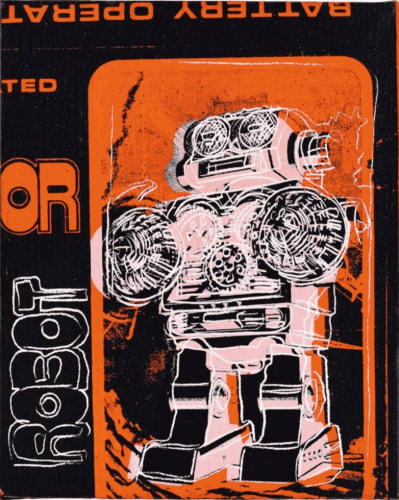Andy Warhol’s Toy Paintings—a body of unique canvases he made in 1983—sit at a fascinating crossroads of late Warhol: they are bright and breezy, seemingly uncomplicated, yet conceptually sharp about desire, branding, childhood, and the global spread of commodities. Commissioned originally for a children’s exhibition by his Zurich dealer Bruno Bischofberger, they were displayed at child-height and clustered by subject like a playroom wall—a mischievous curatorial move that made grown-ups crouch to look. Far from a side note, the series crystallizes many of Warhol’s lifelong obsessions and has become a collectible pocket of the artist’s market, with small canvases that echo the scale of toy boxes while distilling the logic of Pop to its purest form.
What are the Toy Paintings?
The Toy Paintings are small, hand-painted and silkscreened canvases based on toy packaging and advertisements—images Warhol sourced from the international toy market he avidly collected. Robots, parrots, monkeys, pandas, spaceships, ships, airplanes, cars, trains, mice and other characters parade across vivid, flat grounds, their commercial typography and bright inks preserved like badges of authenticity. Warhol’s studio translated those found graphics into synthetic polymer paint and silkscreen ink on canvas, producing one-off paintings rather than editions; sizes often hover around 8 × 10 in. (20.3 × 25.4 cm) or 10 × 8 in. (25.5 × 20.3 cm), with some examples up to 11 × 14 in. (28 × 35.5 cm). They are small enough to feel intimate, yet emphatic enough to read as signs. Works such as Robot (Toy Painting), Parrot, Monkey, Rollover Mouse, Ship, and Moon Explorer sit among the best-known motifs.
Warhol approached the imagery with his familiar Pop toolkit: a photographic screen that fixes the image, then a painterly system of flat color fields that amplify commercial contrast. The result is a comic-book clarity of line and ground that feels both exact and exuberant—an “always new” surface that Pop has long promised. The series counts as unique paintings, not prints; although silkscreen is involved, each canvas is individually painted and screened, with lively shifts in palette that keep the works singular. Gallery and museum presentations have emphasized how the hand and the screen interweave here—less a contradiction than a Warhol constant.
Origin Story: “Paintings for Children”
In 1982–83, Bischofberger asked Warhol to create a show “for children.” Warhol, who loved collecting toys and had an instinctive feel for retail spectacle, ran with the idea. The resulting installation at Bischofberger’s Zurich gallery opened in December 1983 and ran into March 1984. Warhol insisted the canvases be hung at the eye level of a five-year-old, grouped by toy type, sometimes against specially printed wallpaper (fish was one playful motif). Accounts from the time note that adults had to bend or crouch to view the work; some reports even recall a child-accompaniment rule for admission with proceeds directed to charity—characteristically mixing commerce, theater, and philanthropy. Later U.S. iterations and press coverage continued to frame the series as a kid-facing exhibition with a serious Pop charge.
The children’s-show brief wasn’t a gimmick. It repositioned the spectator, forcing adults—the usual arbiters of “high art”—to view on children’s terms and literally lower themselves to meet the work. In Pop, the vantage point is everything: billboards loom above us; tabloids and TV shout at us; cereal boxes stare from waist height. Warhol’s hang turned the gallery into a retail aisle seen by its intended audience, asking adults to embody a consumer stance they’d outgrown but never truly escaped. It was brilliant and disarming.

What’s in the Toy Painting Series?
While no single checklist has every painting, the iconography is well-documented across auction records, gallery catalogues, and museum notes. Among the most recurrent motifs are:
-
Robot (Toy Painting): a classic wind-up humanoid robot rendered with poster-like crispness.
-
Parrot: flamboyantly colored parrots likely lifted from packaging illustrations; variants range from 10 × 8 in. to 14 × 11 in..
-
Monkey: an affable simian, sometimes tied to toy-drummer imagery; Warhol borrowed the packaging as much as the toy itself.
-
Rollover Mouse: based on a Japanese wind-up mouse package, one of the most cited examples in catalog essays.
-
Transport toys—Ship, Train, Moon Explorer, Airplane—capture mid-century fantasies of motion and discovery, seen through the copywriter’s lens.
Across the set, Warhol preserved much of the commercial typography, letting brand voice, product names, and simple slogans punctuate the field. That lettering—so crucial to packaging—becomes visual music when enlarged and isolated, not unlike the Campbell’s Soup labels that launched Warhol’s Pop. The delight is in the double take: we smile at the toy, then notice we are looking at a designed advertisement masquerading as a picture of a toy.

Why Toys? Why Packaging?
Warhol’s Pop was always about the interfaces of desire—how images make us want. In ads, celebrity photos, product shots, and newspaper pictures, he found the short circuits of mass emotion. Toys are a perfect laboratory: they are miniature promises. Their boxes and ad spreads are composed to arrest a child’s glance, to cue recognition, to propose a story the child can finish with play. By pulling that surface into fine art, Warhol showed how much of culture is engineered at eye level long before we can read art history.
It also matters that Warhol’s toys were global. His collection included mechanical and tin toys from Japan, Hungary, China, Germany, Russia, Korea, and the United States, and the paintings keep their international mix, yielding packaging in varied languages and styles. The Toy Paintings thus map Pop’s world-system: design language becomes a lingua franca of cute, speed, and fun, ported across borders through commerce.
The Technique: Hand and Screen
Like much of Warhol’s mature work, the Toy Paintings fuse silkscreen with hand-applied paint. The screen fixes the graphic (the toy illustration, logo, and product name); the brush fills the ground or blocks shapes with loud, solid colors. In places the register is loose—deliberately so—creating small offsets at edges where color meets line. That slight misregistration mimics the cheap print feel of mass packaging, drawing attention to the production values of the source. It also gives Warhol painterly latitude: two “Parrot” canvases can read differently simply because he changed the ground or nudged the placement of the screen.
This balance resonates with Warhol’s 1980s work more broadly, where he toggled between graphic clarity and gestural surfaces (think of the Camouflage, Rorschach, and Oxidation series in the same decade). The Toy Paintings stake out the graphic end of that spectrum, but they remain unmistakably hand-touched objects—something collectors of the series often emphasize.
The 1983 Zurich Installation: Curating Childhood
The Zurich show is one of Warhol’s most memorable installations. Hanging the works at child-height effectively re-authored the gallery space. Groups were arranged by theme—robots with robots, birds with birds—so the walls read like aisles in a toy store. In some presentations, Warhol used custom wallpaper to intensify the sense of immersion. Press accounts later noted the humor and clarity of this curatorial gambit.
Beyond the sight gag, the hang encodes a thesis: context scripts meaning. In a white cube, a 10 × 8 canvas can be a grand statement; at child-height, it becomes a functional picture—a sign meant to be recognized by small, eager bodies. Warhol didn’t just show toy pictures; he staged how pictures behave.

Place in Warhol’s Oeuvre
The Toy Paintings belong to the late Warhol surge of the early-to-mid 1980s, when he revisited and reframed Pop strategies with new subjects and brighter, high-contrast palettes. Think of Myths (1981), Endangered Species (1983), Ads (1985), Guns, Knives, Crosses, Jews, Camouflage, and the grand Last Supper cycle (1986). Within that lineup, the Toy Paintings perform several crucial roles:
-
Packaging as Portraiture
Warhol had long made portraits of commodities: soup cans, Brillo boxes, Coke bottles. The Toy Paintings extend that tradition to toy brands, which are portraits not of a product’s use but of its promise. -
Global Pop
The toy sources are transnational, reflecting a world where design idioms circle the globe. -
Scale and Accessibility
Unlike the monumental Shadows or sprawling Last Suppers, the Toy canvases are domestic in scale and therefore invite a different kind of collecting and display. -
Humor and Sincerity
Warhol’s poker face often masked a deeply sincere fascination with the way images colonize feeling. The Toy Paintings let him be overtly playful without sacrificing edge.
Market Performance and Collector Appeal
The Toy Paintings have a steady auction and private-market presence. The size, the uniqueness of each canvas, and the instantly legible subjects make them attractive to a wide range of collectors. Works such as Robot (Toy Painting) and Parrot trade regularly, while Rollover Mouse has garnered special attention in catalogue essays. Size, palette, subject, and condition all drive valuation, as does provenance—particularly when a canvas traces back to Galerie Bruno Bischofberger.
The Zurich show’s lore also feeds demand. Accounts describe an original run of around 128 toy paintings. That finite, story-rich origin—paired with the series’ role in late Warhol—supports long-term confidence among Warhol buyers who want something quintessentially Pop yet distinct from the more ubiquitous celebrity portraits.
From a collecting strategy perspective, the Toy Paintings offer several lanes:
-
Iconic Characters (e.g., Robot, Parrot, Monkey) that appear frequently enough to compare palettes and conditions across sales.
-
Transport Fantasies (Ship, Train, Moon Explorer) that resonate with design collectors and those interested in Cold War-era futurism.
-
Japanese Packaging (Rollover Mouse) where typography and graphic style are especially pronounced.
Because these are unique paintings, not prints, condition reports matter: look closely at surface scuffs, screen integrity, and any retouching in large flat fields. Mounting and framing can materially affect how crisp those color planes read—clean, non-dominant frames tend to serve the work best.
Popularity and Cultural Importance
The popularity of the Toy Paintings rests on three pillars:
-
Instant Readability
In a fraction of a second, viewers grasp the image and feel its hook. Pop’s power is speed—an image that “works” before you can rationalize why. Toys are engineered precisely for that response; Warhol simply points to it, enlarges it, and canonizes it. -
Childhood as a Design Problem
The series captures how visual systems shape us early: color harmonies, cute character design, action verbs like “roll over,” type hierarchies, and brand mascots. Warhol’s child-height hang dramatized that reality and helped cement the series’ reputation as a wry, brainy exhibition. -
Bridge to Late Warhol
For museums and collectors, the Toy Paintings are a perfect teaching tool: they connect 1960s Pop strategies to 1980s global branding and to Warhol’s own late-career installation savvy.
How the Series Talks to Warhol’s Other Work
-
To the Soup Cans and Brillo Boxes:
The Toy Paintings reassert the package as art—this time not a label or box itself, but the image of the package. If the 1960s works declared the store as subject matter, the 1983 toys remind us that the store trains the eye from the beginning. -
To the Celebrity Portraits:
Toys are celebrity proxies for children. They embody identity—robot, cowboy, panda—much as Monroe or Elvis do in the adult imagination. The Toy Paintings, in other words, are proto-portraits, routing desire through brand fictions. -
To the Ads and Myths:
The Toy canvases demonstrate that an ad is a myth: a compact story of capability, adventure, or cuteness. Warhol’s Ads portfolio later turns that observation toward adult commodities, but the logic is the same. -
To Camouflage and Rorschach:
Where Camouflage and Rorschach meditate on surface and signal without figuration, the Toy Paintings show figuration as surface—almost all signal, engineered to be seen across a room (or an aisle). The flat color planes in Toy often anticipate the decorative hit of Camouflage.

Exhibition and Afterlives
Although conceived for Zurich, the Paintings for Children theme reappeared in subsequent exhibitions and museum programming, including child-height installations and interactive experiences that use Warhol’s toy imagery to introduce silkscreen and Pop strategies to younger audiences. Contemporary galleries have periodically reassembled selections of Toy canvases to underline the series’ coherence and charm, and 21st-century viewing rooms continue to showcase the work as a gateway into late Warhol.
Why They Matter Now
In an age of unboxing videos and algorithmically optimized thumbnails, the Toy Paintings feel almost prophetic. Warhol understood that packaging is performance—a designed encounter between image and impulse, stage-managed to spark the little jolt we call wanting. By immortalizing toy boxes on canvas, he made a timeless point about how we learn to look and how markets choreograph that learning. The works endure because they’re funny and frank, innocent and cunning—a paradox that could double as Warhol’s signature.
Collectors and curators keep returning to the series because it delivers on every Warhol vector at once: brand, surface, desire, repetition, wit, and the politics of display. Its small scale makes the canvases livable; their conceptual bite makes them museum-ready. The very best examples—clean screens, strong color, appealing subjects, solid provenance—fit seamlessly into Warhol collections that span 1960s to 1980s, while also anchoring focused vignettes about consumer culture and childhood.
A Short Guide for New Collectors
If you’re considering a Toy Painting, think about:
-
Subject appeal and palette. Robots, parrots, and mice carry broad recognition; unusual hues or especially punchy grounds can be decisive.
-
Scale and condition. The small canvases often show every nick; request high-resolution condition reports and pay attention to any abrasions in flat fields.
-
Provenance. Early links to Galerie Bruno Bischofberger are meaningful; auction histories at major houses help establish confidence.
-
Context. Pairing a Toy Painting with a 1980s Ads print, or with a 1960s product work, makes the conceptual arc visible in a single wall.
Warhol’s Toy Paintings compress Pop’s entire thesis into hand-sized canvases: images make us want; design teaches us to see; childhood is already a marketplace of signs. Born from a cheeky commission for children, they have matured into an essential chapter of late Warhol—an art-historically resonant, market-tested series whose charm never cancels its bite. Whether you come to them as a Warhol completist or as a new collector looking for a museum-grade idea in a small frame, the Toy Paintings deliver a remarkably pure dose of what made Warhol Warhol: a clear eye for the world as it is, and an even clearer sense of how pictures run it.
Discover Andy Warhol original art for sale and contact our teams via info@guyhepner.com for current availabilities.


